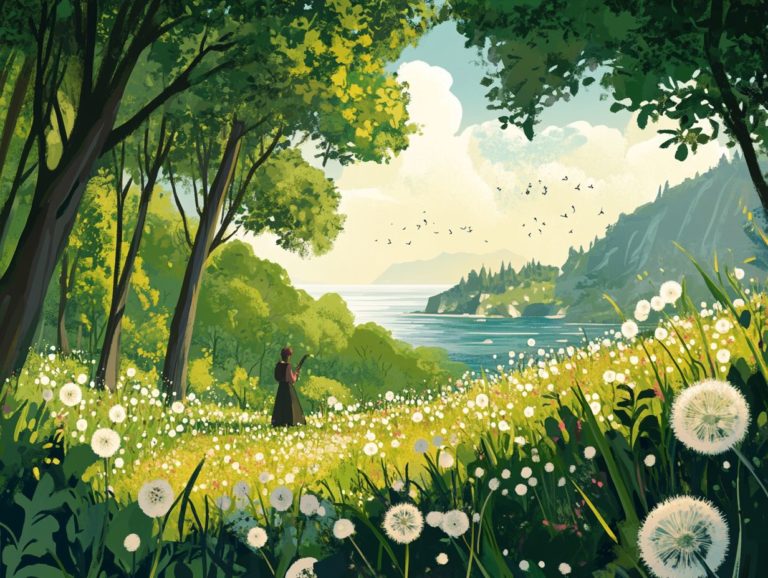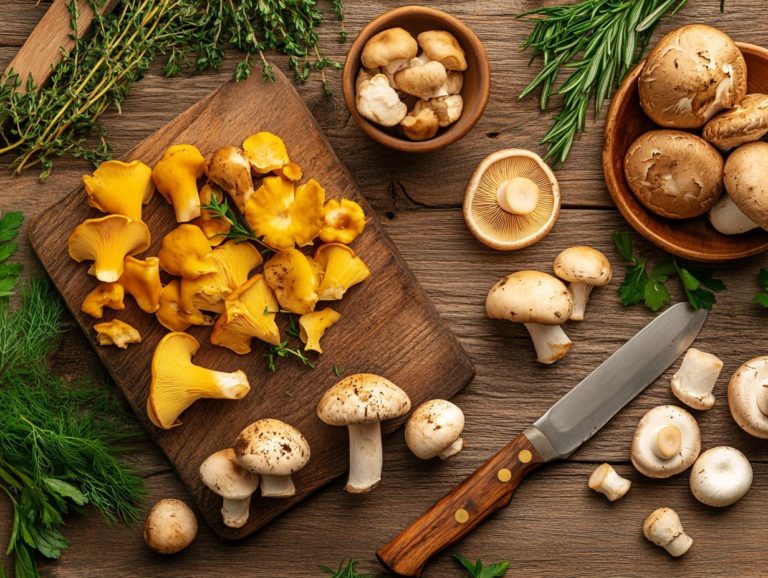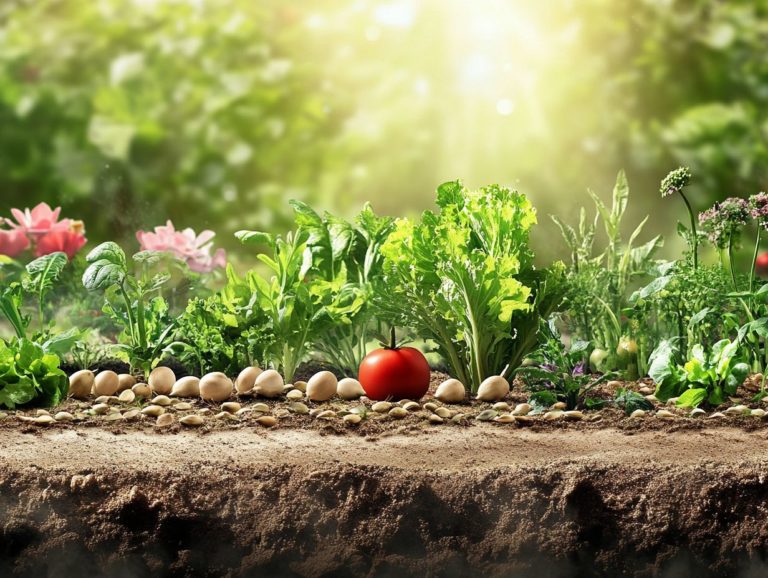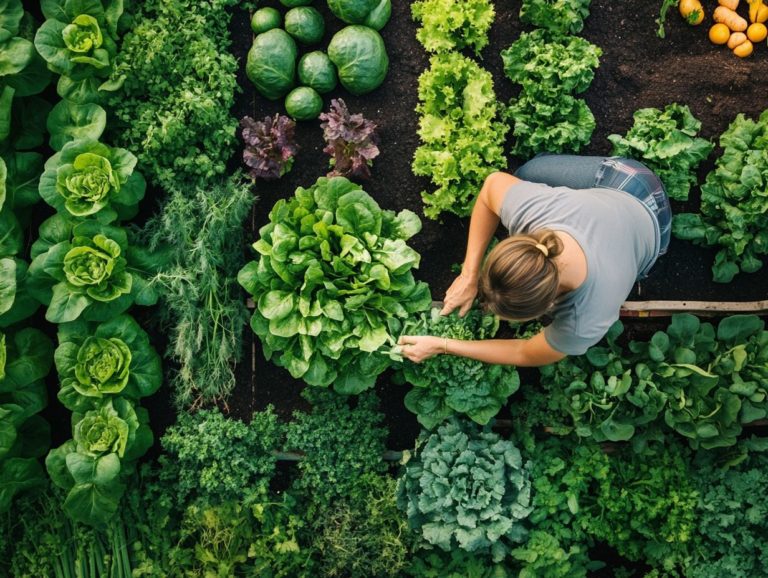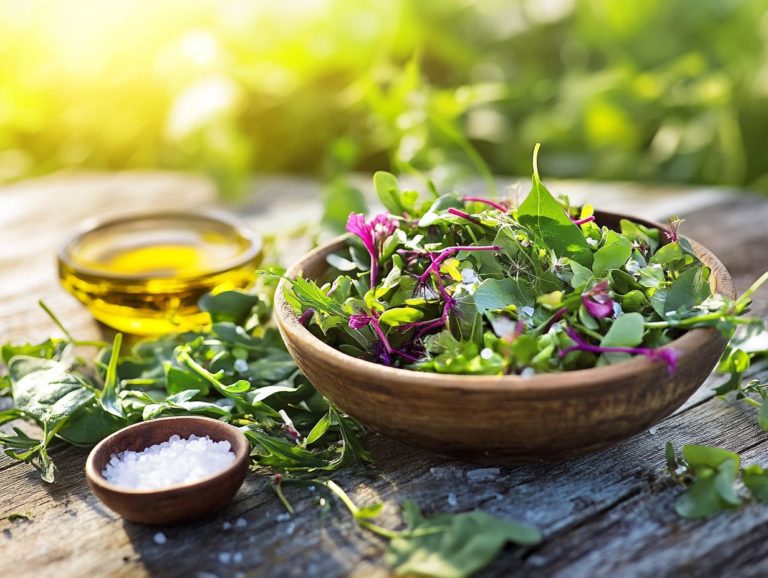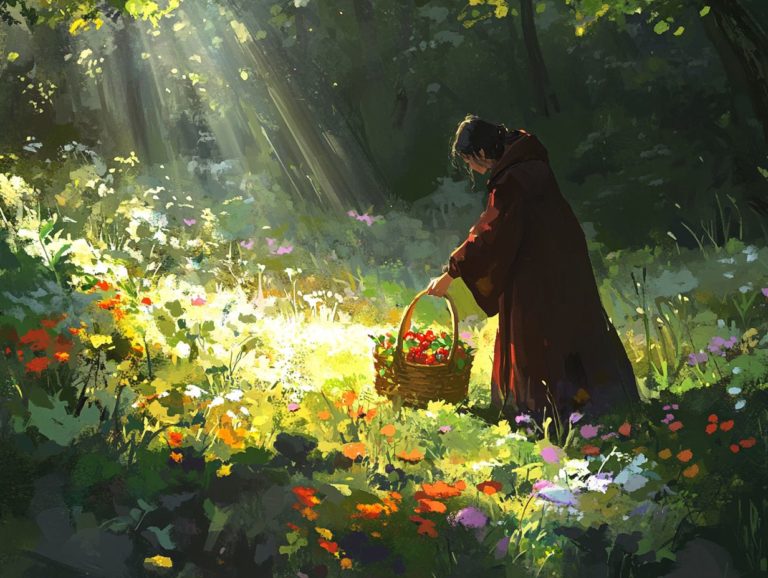How to Safely Harvest Edible Mushrooms
Harvesting your own mushrooms presents a rewarding and delectable adventure. Not only does it deepen your connection with nature, but it also allows you to indulge in the pleasure of savoring fresh, home-picked fungi.
You ll discover how to identify edible mushrooms, spot their poisonous look-alikes, and master safe harvesting techniques.
Best practices for storing and preserving your bounty will be shared, along with tips and recipes that will transform your edible fungi into culinary masterpieces.
Dive into this exciting world of mushroom foraging and elevate your skills to new heights!
Contents
- Key Takeaways:
- Identifying Edible Mushrooms
- Safety Precautions
- Harvesting Techniques
- Storing and Preserving Mushrooms
- Preparing and Cooking Edible Mushrooms
- Frequently Asked Questions
- What are some common types of edible mushrooms that can be safely harvested?
- Can I safely pick mushrooms from my backyard or local woods?
- What are some important things to keep in mind when harvesting mushrooms?
- How can I tell if a mushroom is safe to eat?
- What should I do with the mushrooms after harvesting them?
- Are there any precautions I should take when harvesting mushrooms?
Key Takeaways:
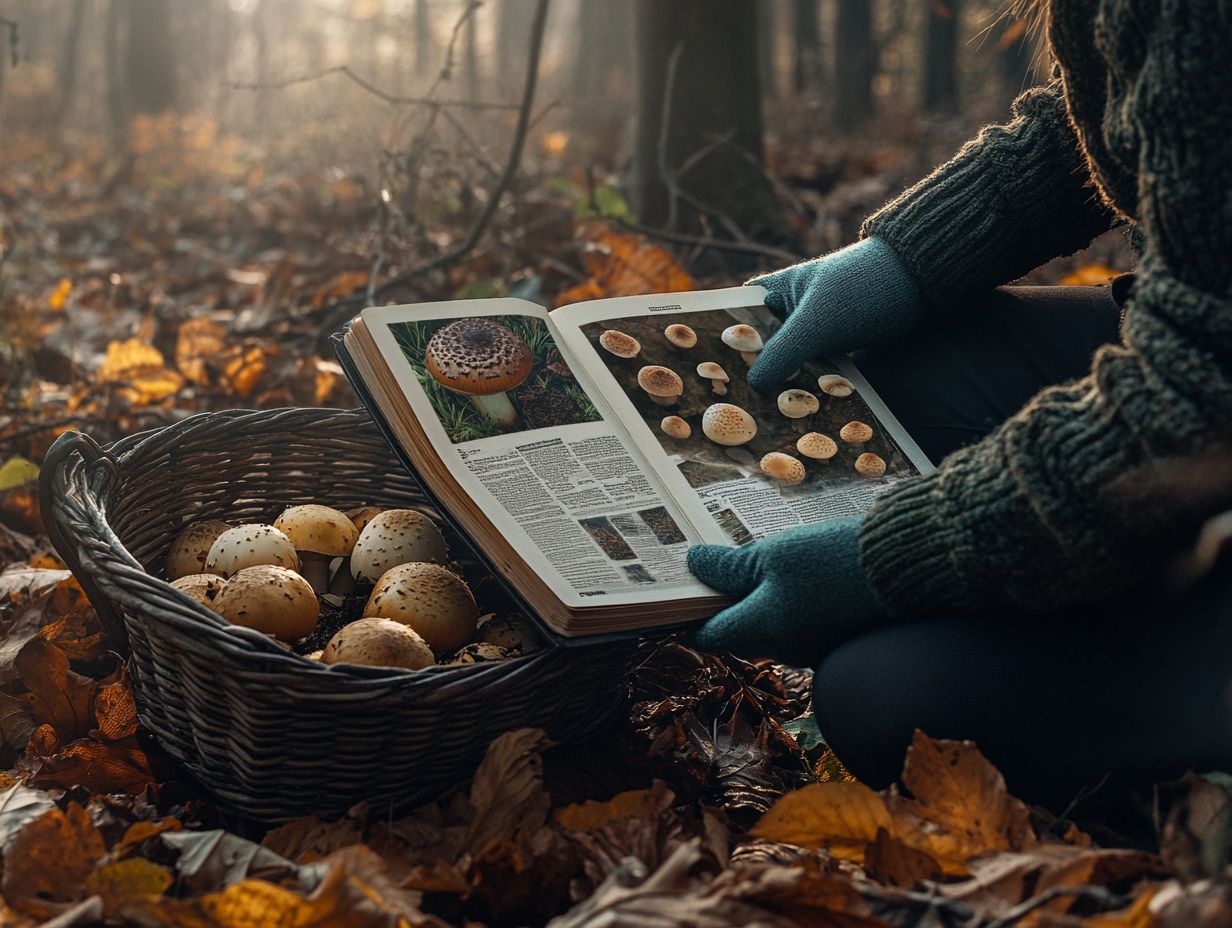
- Identify edible mushrooms by their unique features before harvesting.
- Stay safe by learning about poisonous look-alikes and using the right tools.
- Preserve your mushrooms properly to enjoy in delicious meals.
Benefits of Harvesting Your Own Mushrooms
Harvesting your own mushrooms not only adds a fresh, flavorful touch to your meals but also deepens your connection with nature and promotes sustainable practices. This activity encourages you to engage with the forest ecosystem, understand how ecosystems work, and appreciate the significance of responsible foraging while considering ecological factors.
By immersing yourself in the mushroom community, you gain access to a wealth of knowledge about wild mushrooms, including chanterelles and other delectable fruit bodies, enhancing your foraging skills.
Engaging in mushroom harvesting supports local economies and fosters community involvement. As you gather mushrooms, you might share your bounty or sell it at local markets, creating a sense of camaraderie that encourages sustainable business practices among mushroom hunters.
The ecological impact of foraging is profound; responsible harvesting helps maintain fungal populations and supports local wildlife habitats, ultimately contributing to biodiversity.
The personal health benefits are remarkable, as many wild mushrooms are rich in nutrients, antioxidants, and even medicinal properties that can enhance your overall well-being while also supporting mushroom reproduction.
By connecting with nature and embracing this holistic approach, you enrich your life and contribute to a healthier planet.
Identifying Edible Mushrooms
Identifying edible mushrooms is essential for safe foraging, and knowing the best time to forage edible fungi requires a solid understanding of the many mushroom species and their distinguishing characteristics.
You ll need to hone your skills in mushroom identification techniques, paying close attention to key features like color, shape, and habitat.
Joining a mycology club (a group that studies fungi) can significantly enrich your knowledge, providing invaluable resources and a supportive community to help you confidently identify those delectable fungi while sharing fungal observations.
Characteristics of Edible Mushrooms
Edible mushrooms showcase distinct characteristics that set them apart from their non-edible counterparts, including unique colors, textures, and spore distributions. By grasping these features, you can enhance your foraging skills and identify mature mushrooms while steering clear of potential culinary hazards. Key identification traits such as cap shape, gill structure, and habitat are essential for recognizing different mushroom species.
For example, the vibrant orange hue of chanterelles or the sumptuous deep brown of porcini they serve as striking indicators of edibility. Notice how the smooth, rounded caps of button mushrooms contrast with the rugged texture of shiitakes, which boast a distinctive umbrella-like shape.
When you examine the gills, crucial details come to light; the free gills of a morel can help you distinguish it from potentially toxic lookalikes. By understanding these visual cues, along with the specific environments where these fungi thrive like the lush undergrowth of forests or the damp edges of meadows you will cultivate a deeper appreciation for mushrooms and practice safer foraging.
Start your mushroom harvesting journey today!
Safety Precautions

Safety precautions are essential when foraging for wild mushrooms. Getting confused about edible varieties poses significant health risks. To enhance your foraging knowledge, refer to the ultimate guide to edible fungi, and ensure you equip yourself with strong mushroom identification skills while developing a keen awareness of mushrooms that look similar but are poisonous.
You can significantly minimize costly mistakes by adhering to responsible foraging practices and seeking guidance from seasoned foragers.
Common Poisonous Look-Alikes
Common poisonous look-alikes pose significant challenges for you as a forager. Accurately identifying edible mushrooms can be tricky. Species like Amanita and wood blewit often mimic the features of their edible counterparts. It’s essential for you to grasp the key differences between them.
Familiarizing yourself with toxic species such as shaggy parasol and honey fungus ensures a safe foraging adventure.
Identifying poisonous mushrooms demands keen observation and meticulous attention to detail. Even the slightest variation can mean the difference between safety and danger. For example, the notorious Amanita phalloides, or death cap, can easily be mistaken for the harmless paddy straw mushroom. Pay close attention to traits like gill attachment, cap shape, and spore print color.
Knowing where mushrooms grow, like damp woodlands or grassy areas, helps in identifying them. If you’re ever in doubt, photograph the specimens and consult reliable field guides or local foraging groups. Remember the golden rule: when in doubt, toss it out.
Harvesting Techniques
Adopting the right harvesting techniques is essential for ensuring sustainable mushroom growth and maintaining the delicate ecological balance within forest ecosystems. Choosing between cutting and pulling mushrooms affects their life cycle. It’s vital for foragers like you to be mindful of your picking methods to minimize disruption to the mycelium (the underground network that supports mushroom growth).
Embracing sustainable practices not only boosts your foraging success but also fosters the long-term health of mushroom populations.
Tools and Methods for Picking Mushrooms
Equipping yourself with the right tools and mastering effective methods for picking mushrooms can significantly elevate your foraging experience. A sturdy mushroom bag is essential for collecting your harvested fungi while minimizing the risk of damaging those delicate mushroom trimmings.
A sharp knife is essential for neatly severing mushrooms at their base. This preserves both the fungi and the mycelium beneath the surface. It promotes ongoing growth and champions sustainability in the area. Investing in a field guide can also prove invaluable, aiding you in accurately identifying edible species while steering clear of toxic varieties.
By emphasizing sustainable practices such as ensuring only mature mushrooms are taken you contribute to maintaining the delicate balance of forest ecosystems. Cultivating a respectful approach toward nature during your foraging adventures enriches your experience and safeguards the environment for future harvests.
Storing and Preserving Mushrooms

Storing and preserving mushrooms correctly is essential for keeping their flavor and nutritional value intact over time. By adopting best practices for long-term storage, you can significantly reduce mushroom waste. This helps minimize the environmental impact that comes with improper preservation methods.
Techniques like drying, freezing, and pickling not only help maintain the mushrooms integrity but also allow foragers to relish their harvest throughout the year. This protects the delicate forest health.
Best Practices for Long-Term Storage
Implementing best practices for long-term storage of mushrooms is essential for preserving their flavor, texture, and nutritional quality. Techniques such as proper drying methods and vacuum sealing removing air from packaging to keep food fresh can significantly extend the shelf life of your harvested mushrooms while minimizing waste.
By choosing environmentally sustainable preservation strategies, you can savor your culinary treasures while reducing your ecological footprint. Understanding the details of different storage methods allows you to maintain the mushrooms’ natural goodness over time.
For instance, dehydrating mushrooms not only concentrates their flavors but also prevents spoilage, transforming them into a versatile ingredient for future meals. When done correctly, freezing locks in nutrients while preserving the mushrooms’ original taste and texture.
Using organic practices is also important to ensure minimal impact on surrounding ecosystems during foraging and storage. By adopting these responsible methods, you benefit both the mushrooms and the environment, ultimately leading to a more sustainable way of enjoying nature’s bounty.
Preparing and Cooking Edible Mushrooms
Unlock the joy of cooking with mushrooms! They can transform your meals into memorable culinary adventures. Whether you’re saut ing delicate chanterelles or incorporating earthy morels into gourmet creations, mastering different preparation techniques, including various cutting methods, can elevate your dining experience.
Engaging with the mushroom community by sharing recipes and cooking tips not only enhances your appreciation for these exquisite fungi but also sparks creativity in your kitchen endeavors.
Tips and Recipes for Delicious Meals
Creating delicious meals with mushrooms offers a rewarding experience that elevates both flavor and nutrition in your culinary repertoire. Whether you re whipping up a classic mushroom risotto or experimenting with an innovative stir-fry, the versatility of these edible fungi opens up a world of culinary possibilities.
Engaging with fellow mushroom enthusiasts can ignite creativity and provide you with invaluable tips and recipes that celebrate the rich, earthy flavors of wild mushrooms.
To unlock the full culinary potential of mushrooms, consider techniques such as saut ing them with garlic and fresh herbs, or roasting to achieve a beautifully rich, caramelized finish. These methods enhance their innate flavors and create a delightful harmony when paired with other ingredients.
For instance, integrating saut ed mushrooms into a creamy pasta dish can add depth, while a hearty mushroom soup brings warmth and comfort to any table, showcasing the versatility of various mushroom species.
Don t shy away from experimenting with different mushroom varieties think shiitake, portobello, or chanterelles to further diversify your dishes and learn about their mushroom growth processes. Each type offers a unique flavor profile, making every meal an exciting adventure in taste.
Frequently Asked Questions

What are some common types of edible mushrooms that can be safely harvested?
Some common types of edible mushrooms include shiitake, oyster, chanterelle, porcini, and morels, which are popular among foragers.
Can I safely pick mushrooms from my backyard or local woods?
It is generally safe to harvest mushrooms from your backyard or nearby forests, as long as you can properly identify them and know they are safe to eat. For more detailed information, refer to the forager’s guide on identifying safe edibles.
What are some important things to keep in mind when harvesting mushrooms?
When harvesting mushrooms, always carry a guidebook or have knowledge of local mushroom species, wear appropriate clothing and protective gear, and use a sharp knife or scissors to cut the mushrooms. Additionally, following safety guidelines for harvesting wild edibles is crucial for a safe foraging experience.
How can I tell if a mushroom is safe to eat?
The best way to determine if a mushroom is safe to eat is by using a guidebook or consulting a local expert in mushroom identification. Key characteristics to look out for include the shape, color, gills, and smell of the mushroom, which are essential mushroom identification features.
Ready to dive into the world of mushroom foraging and cooking? Start experimenting today and enjoy the delightful flavors they bring to your table!
What should I do with the mushrooms after harvesting them?
After harvesting mushrooms, clean them thoroughly to remove dirt and debris. Store them in a mushroom bag or basket in a cool, dry place.
Use the mushrooms within a few days for the best flavor. Freshly harvested mushrooms taste amazing!
Are there any precautions I should take when harvesting mushrooms?
Never eat a mushroom unless you can identify it reliably. Use trusted resources or guides for mushroom identification.
Avoid harvesting mushrooms near roads, industrial areas, or places where pesticides might have been used. Following wild edibles safety tips helps keep your foraging safe and enjoyable.

